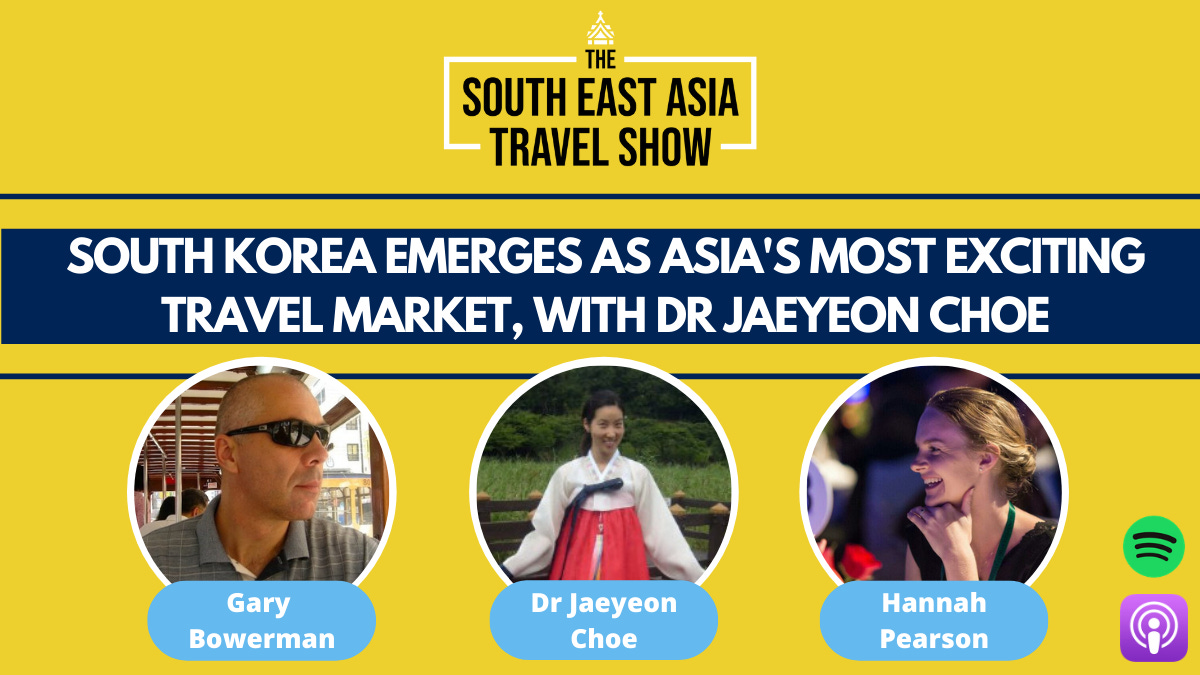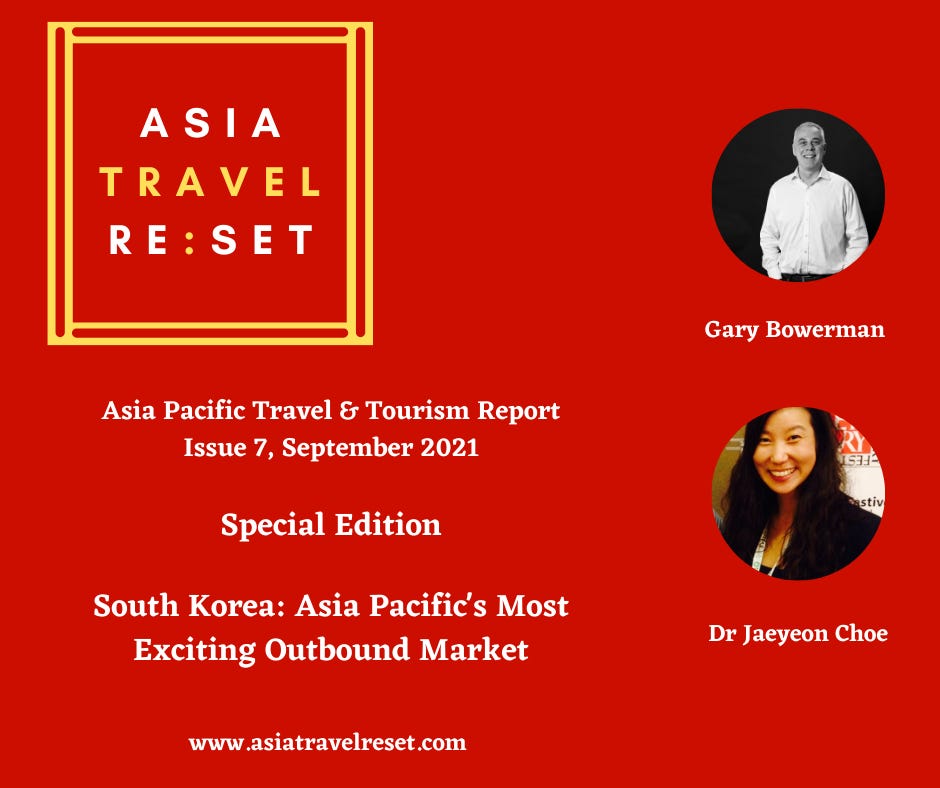Asia Pacific Travel & Tourism Report #7 - South Korea Special Edition
A close-up look at Asia Pacific's most dynamic outbound market in 2021.
Hello. Welcome to the 7th Asia Pacific Travel & Tourism Report…
This month, we take a close-up look at South Korea, which emerged this summer as Asia Pacific’s most vibrant outbound market.
Unlike much of the region, South Koreans are travelling overseas and will continue to do so this winter, so destination marketers should be checking their travel preferences.
As always, this report is co-produced with Dr Jaeyeon Choe, who is currently in Seoul.
If you like the report, please share it with a colleague by using the button below.
Thanks for being on board,
Gary
South Korea: Asia Pacific’s Most Exciting Outbound Market
Assessing the returning appetite for travel in the second half of 2021 - and into 2022.
1) Leading the Vaccinated Travel Era
Regular readers of our monthly report will know that Jaeyeon has closely tracked the travel upswing in South Korea. In June, she revealed South Koreans’ summer travel plans, and in July, the ‘romantic’ camping trend. In August, we checked out a new South Korea-Saipan travel bubble.
Summer 2021 saw a revival in outbound trips from South Korea, with travel firms and airlines offering spectacular discounts. Winter bookings are already strong.
Vaccines are boosting travel confidence. As of 1 October, South Korea’s fully vaccinated rate was 49.06%.
Although unvaccinated South Koreans are required to do a 14-day quarantine on their return, fully vaccinated South Koreans are exempt from quarantine.
Despite the positive recent developments, we can’t escape the COVID carnage. Like all countries, South Korea’s travel industry has been deeply impacted.
A new government report estimates the pandemic has caused a KRW8.82 trillion deficit for the nation’s culture, sports and tourism sectors.
There is much work to do to build a recovery - but South Korean travellers are actively booking and travelling once again.
2) Assessing the Airport Data
Incheon International Airport handled 1,813,729 passengers in the first 8 months of 2021. This compares to 1.37 million at Singapore Changi, and 711,000 at Hong Kong International.
Domestic airports handled 44,354,819 passengers during the same period; 16.4 million of which passed through Jeju Island, and 14.4 million through Seoul Gimpo.
Both these inbound and domestic totals are way down on 2019, but it’s time to stop benchmarking against a year that won’t be replicated any time soon (in most Asia Pacific markets).
The primary positivity is found in South Korea’s summer 2021 statistics. 48% of year-so-far passenger traffic at Incheon International occurred from June-August.
By contrast, domestic airport traffic from June-August accounted for 41% of the year-so-far total suggesting that summer sentiment shifted slightly towards overseas trips.
3) Charting Chuseok Holiday Bookings
Some 59,000 South Koreans passed through Incheon International Airport for the Chuseok holiday (17-22 September), up 67% on 2020. Across September, 216,000 travelled abroad. This number is gradually increasing as the end of 2021 approaches.
While most Asian destinations remain closed, South Koreans took long-haul trips to European destinations, such as France, Czech Republic, Switzerland, Italy and Spain.
South Koreans choosing European destinations are thinking differently. Many people booked for small towns in Southern France, with cultural activities like winery tours. Popular tour packages to Switzerland included ‘nature healing’ and mountain hiking.
4) Pacific Island Escapes: Saipan & Guam
During July, the first month of the Saipan-South Korea Travel Bubble, 42 tourists visited Saipan. Yet, 272 tourists flew to Saipan for the 5-day Chuseok national holiday.
Looking ahead, 4,000 South Koreans have booked to Saipan for the rest of the year.
Guam accepts all tourists with a negative PCR test without vaccination certificates, while Saipan requires a 5-day hotel quarantine. Guam has no quarantine rule, and over 80% of locals have been fully vaccinated. This makes Guam more attractive.
Korean Air currently flies to Guam from Incheon once a week, and will increase to twice a week in December. Many honeymooners are now looking at Guam. Industry experts predict that South Korean honeymooners might seek more private forms of accommodation and luxury programmes in 2022.
Hawaii and Maldives are also tipped as honeymoon hot picks.
CLICK HERE to listen to Jaeyeon talking all things travel and tourism in South Korea during the summer with Gary and Hannah on The South East Asia Travel Show.
5) Demand Surge for Winter & Lunar New Year
The most-booked destinations for early 2022 are Hawaii (24%), Paris (14%), Guam (12%) and the Maldives (6%), according to Interpark, a major travel agency in South Korea.
After the US announced an easing of travel restrictions in November, bookings are increasing. South Koreans in their 20s and 30s are booking individual trips to Europe where less travel restrictions apply, especially France, Switzerland, Italy and Spain.
Korean travel news predicts that from mid-November, travel demand will surge as the majority of adults will be fully vaccinated, and demand will peak during the Lunar New Year holiday in early February 2022.
Meanwhile, a major business newspaper predicts that there might be a shortage of air tickets to popular destinations in 2022. In response, Hana Tour announced that 1,100 of its 1,200 employees have returned to work by 1 October.
And the focus is anticipated to shift away from traditional package tour programmes to create more diverse travel products focusing on individual needs and aspirations.
6) When Will South Koreans Return to South East Asia?
As talk turns to partially restoring inbound travel to South East Asia via Sandboxes and Vaccinated Travel Lanes, the region risks missing out on South Korean visitors.
In 2019, South Korea was the 3rd-largest source of arrivals to the 10 countries of South Asia East - supplying 10.46 million visits. China topped the list with 32.3 million, with Singapore 2nd on 13.8 million visits.
The prospects for South Koreans returning seem low while ASEAN governments mandate quarantine-on-arrival. Thailand this week cut quarantine for Sandbox islands from 14 to 7 days. That remains a turn-off for many intra-Asia travellers who tend to favour short trips because of a low level of paid annual leave. Shame, because travel blog interest about Thailand is rising in South Korea.
Destinations to watch include Malaysia (which is nearing a 90% vaccination threshold for the adult population), Vietnam and the Philippines. The latter two are favoured by South Korean tourists, while Malaysia was popular for ‘one-month stay’ travel in 2019.
But with European nations offering much easier entry and greater travel freedoms, South East Asian nations will need to rethink their strategies or risk missing out.
7) Emerging Domestic Trip Trends
During the COVID period, large numbers of South Koreans took short car-based leisure trips, including car camping. Visiting places near to home for short (day) trips, they chose nature spots for ‘mental healing’ and to explore trending dining venues.
However, a small segment chose longer ‘one-month stays’ in remote and quiet areas.
Travelling with pets has also become increasingly popular.
Domestic tourists are growing tired of carrying and cooking their own food, and are searching social media for popular gastro-tourism restaurants.
As more people become fully vaccinated, interest is turning to seeking pleasure rather than safety. The #1 travel spend item is ‘Food and drinks’. Some commentators argue that ‘revenge consumption’ is occurring by way of domestic trips and food purchases.
South Koreans desire experiential activities, and base their choice of café, restaurant and accommodation on unique designs and activities for social media sharing.
While domestic tourists continue to choose destinations such as Jeju island, Gangwon province and Busan, they are also exploring rural villages and small islands. This is helping to diversify domestic tourism and bolster rural economies.
During the Chuseok national holiday in September, domestic tourists chose hotels (40.7%) over pensions; and glamping and caravans were more popular than ever.
8) Multimedia Tourism Marketing
Pre-pandemic, South Korea’s expertly packaged K-pop, tech and TV culture played a central role in its destination marketing strategy. K-beauty and aesthetic treatments also enticed travellers from China and other nearby nations.
As a new era of travel beckons, South Korean popular culture and its biggest stars will help drive the nation’s travel marketing worldwide.
Global phenomenon BTS kickstarted Seoul’s pop-tourism promotions in 2018. Having kept South Korea in the global news during the pandemic - whether by selling McDonald’s meals, modelling for Louis Vuitton or dancing at the UN General Assembly - they’re back with a new tourism video: Your Seoul Goes On.
It is a brilliantly glossy piece of youth-focused destination video marketing.
Meanwhile, 4-member girl megaband Blackpink have been promoting Pepsi across Asia, modelling for Chanel and Dior and appearing in GQ, Grazia and Elle.
The value of BTS, Blackpink and other K-pop stars for promoting South Korea to youthful Asian travellers should not be overlooked. South Korea’s virtual-tech pavilion at the now-open Dubai Expo - the 5th-largest at the event - will host K-pop concerts.
Meanwhile, Korean TV dramas and movies, which are watched avidly across the region, feature carefully curated landscape and landmark shots. Netflix mini series Squid Game is taking the TV world by storm, and Park So-dam, star of the Oscar-winning movie Parasite, is the Honorary Ambassador of Performing Arts Tourism.
And the Korean Tourism Organisation’s new fashion-forward Feel the Rhythm of Korea Season 2 video series is deftly choreographed for a new travel era.
K-culture is super hot, and other destinations will incorporate elements into their marketing mix.
This week, Hong Kong Tourism Board signed an MoU with South Korean media group CJ ENM to promote Hong Kong as a destination via TV drama and variety shows from 2022-2024.
It’s the first tourism bureau to ink such a deal in South Korea. It won’t be the last.
Two Trends to Watch…!
9) Travelling Solo!
Over 42% of South Koreans in their 30s are unmarried. Women with a higher education background marry less than others. According to 2019 data, those travelling abroad the most were 31-40 years old (5.41m), 21-30 (4.83m) and 51-60 (4.73m). A rising number of single people travelled alone domestically during the pandemic, and will likely head overseas soon. Solo travellers could be a lucrative segment to target.
10) Tune in to Blogs & Vlogs!
Most young South Korean travellers get their trip-planning tips and ideas from blogs and vlogs. YouTube is a powerful travel influencing and information source. It is more popular among South Korean men than women, while SNS (i.e. Instagram and Facebook) are more popular among women. A large number of influencers have now started travelling (or have been sponsored) to destinations such as Egypt and the US.
Click to read our 6 previous monthly reports:
And, that’s a wrap.
The Asia Pacific Travel & Tourism Report will return on 31 October.
The weekly Asia Travel Re:set newsletter is back next Sunday. Here’s the most recent issue (#56) in case you missed it.
Have a great week,
Gary






